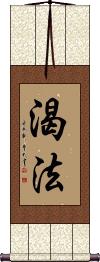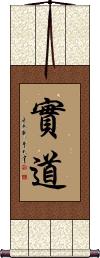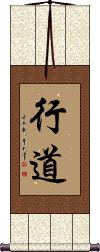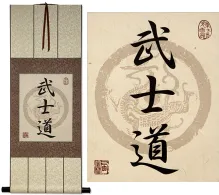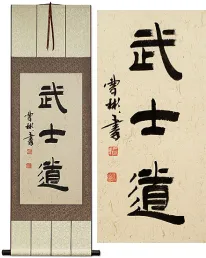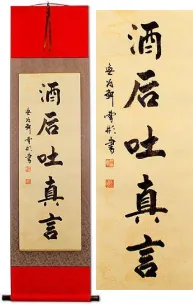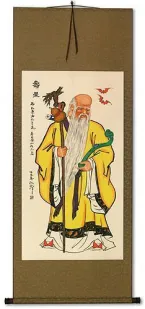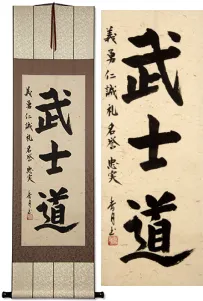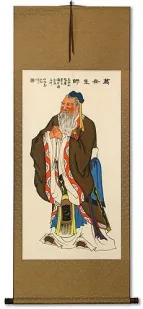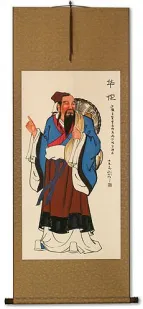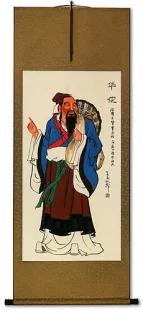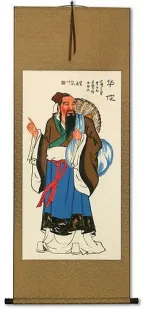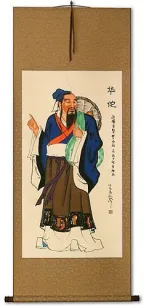Many custom options...
And formats...

The name The Way of the Truth in Chinese / Japanese...
Buy a The Way of the Truth calligraphy wall scroll here!
Personalize your custom “The Way of the Truth” project by clicking the button next to your favorite “The Way of the Truth” title below...
Buddha Seeking
Comparison Leads to Truth and Enlightenment
不比不知道一比吓一跳 is a Chinese proverb that literally means: [If one not does] not make comparisons, [one will] not know [the truth] when [one] compares, [one will be] greatly surprised.
This goes to the idea that if you do not know bad times, you cannot know what good times are.
...And...
You can not know light without experiencing darkness.
Another way to translate this would be: If you wish to be enlightened, you need to make comparisons and analyze every aspect (of a situation, issue, or problem).
Seeking Truth
求道 means seeking for truth, or to seek (practice for, strive for) enlightenment.
求道 is used mostly in a Buddhist context, so some non-Buddhists may not recognize it.
Thirst for Truth
True Religion / Buddha Truth
The way of the truth
Walk in the Way
The Way of Buddha Truth
In Taoist and Buddhist contexts, 行道 means to “Walk in the Way.” In Buddhism, that further means to follow the Buddha truth. In some Buddhist sects, this can mean making a procession around a statue of the Buddha (always with the right shoulder towards the Buddha).
Outside of that context, this can mean route (when going somewhere), the way to get somewhere, etc.
In Japanese, this can be the surname or given name Yukimichi.
This in-stock artwork might be what you are looking for, and ships right away...
Gallery Price: $106.00
Your Price: $58.88
Gallery Price: $200.00
Your Price: $98.88
Gallery Price: $168.00
Your Price: $92.88
Gallery Price: $200.00
Your Price: $118.88
Gallery Price: $200.00
Your Price: $79.88
Gallery Price: $200.00
Your Price: $79.88
Gallery Price: $200.00
Your Price: $79.88
Gallery Price: $200.00
Your Price: $79.88
Gallery Price: $200.00
Your Price: $79.88
Gallery Price: $200.00
Your Price: $118.88
Not the results for the way of the truth that you were looking for?
Below are some entries from our dictionary that may match your the way of the truth search...
| Characters If shown, 2nd row is Simp. Chinese |
Pronunciation Romanization |
Simple Dictionary Definition |
實道 实道 see styles |
shí dào shi2 dao4 shih tao jitsudō |
More info & calligraphy: True Religion / Buddha Truth |
法輪 法轮 see styles |
fǎ lún fa3 lun2 fa lun hourin / horin ほうりん |
More info & calligraphy: Eternal Wheel of Life{Buddh} (See 輪宝,転法輪) the teachings of Buddha (as likened to the Dharmachakra, originally a wheel-like weapon used to destroy the evils of mankind); Buddhist doctrine; (surname) Noriwa dharmacakra, the Wheel of the Law, Buddha-truth which is able to crush all evil and all opposition, like Indra's wheel, and which rolls on from man to man, place to place, age to age. 轉法輪To turn, or roll along the Law-wheel, i.e. to preach Buddha-truth. |
羅漢 罗汉 see styles |
luó hàn luo2 han4 lo han rakan らかん |
More info & calligraphy: Luohan / Lohan(abbreviation) {Buddh} (See 阿羅漢・あらかん) arhat; (place-name, surname) Rakan arhan, arhat; worthy, worshipful, an arhat, the saint, or perfect man of Hīnayāna; the sixteen, eighteen, or 500 famous disciples appointed to witness to buddha-truth and save the world; v. 阿. |
行道 see styles |
xíng dào xing2 dao4 hsing tao yukimichi ゆきみち |
More info & calligraphy: Walk in the WayTo walk in the way, follow the Buddha-truth; to make procession round an image, especially of the Buddha, with the right shoulder towards it. |
道場 道场 see styles |
dào chǎng dao4 chang3 tao ch`ang tao chang doujou / dojo どうじょう |
More info & calligraphy: Dojo / Martial Arts Studio(1) dojo; hall used for martial arts training; (2) (abbreviation) {Buddh} (See 菩提道場) manda (place of Buddhist practice or meditation, esp. the place under the bodhi tree where Buddha attained enlightenment); (surname) Michiba Truth-plot. bodhimaṇḍala, circle, or place of enlightenment. The place where Buddha attained enlightenment. A place, or method, for attaining to Buddha-truth. An object of or place for religious offerings. A place for teaching, learning, or practising religion. |
珠 see styles |
zhū zhu1 chu megumi めぐみ |
bead; pearl; CL:粒[li4],顆|颗[ke1] (1) ball; sphere; globe; orb; (2) bead (of sweat, dew, etc.); drop; droplet; (3) ball (in sports); (4) pile (of noodles, etc.); (5) bullet; (6) bulb (i.e. a light bulb); (7) lens (of glasses, etc.); (8) bead (of an abacus); (9) (slang) (abbreviation) ball (i.e. a testicle); (10) gem; jewel (esp. spherical; sometimes used figuratively); pearl; (11) female entertainer (e.g. a geisha); (12) (derogatory term) person (when commenting on their nature); character; (13) item, funds or person used as part of a plot; (n,n-suf) (14) egg; (suffix noun) (15) coin; (16) precious; beautiful; excellent; (female given name) Megumi mani. A pearl; a bead; synonym for buddha-truth. |
三毒 see styles |
sān dú san1 du2 san tu sandoku さんどく |
{Buddh} (See 煩悩・2) the three kleshas that poison the heart of man (desire, ill will and ignorance) The three poisons, also styled 三根; 三株; they are 貪 concupiscence, or wrong desire, 瞋 anger, hate, or resentment, and 痴 stupidity, ignorance, unintelligence, or unwillingness to accept Buddha-truth; these three are the source of all the passions and delusions. They represent in part the ideas of love, hate, and moral inertia. v. 智度論 19, 31. |
三生 see styles |
sān shēng san1 sheng1 san sheng mitsuo みつお |
(surname, given name) Mitsuo The three births, or reincarnations, past, present, future. Tiantai has (a) 種 planting the seed; (b) 熟 ripening; (c) 脫 liberating, stripping, or harvesting, i.e. beginning, development, and reward of bodhi, a process either gradual or instantaneous. Huayan has (a) 見聞生 a past life of seeing and hearing Buddha-truth; (b) 解行生 liberation in the present life; (c) 證入生 realization of life in Buddhahood. This is also called 三生成佛, Buddhahood in the course of three lives. There is also a definition of three rebirths as the shortest term for arhatship, sixty kalpas being the longest. There are other definitions. |
乘津 see styles |
shèng jīn sheng4 jin1 sheng chin jōshin |
The vehicle and ford to nirvana, i.e. Buddha-truth. |
二教 see styles |
èr jiào er4 jiao4 erh chiao nikyō |
Dual division of the Buddha's teaching. There are various definitions: (1) Tiantai has (a) 顯教 exoteric or public teaching to the visible audience, and (b) 密教 at the same time esoteric teaching to an audience invisible to the other assembly. (2) The 眞言 Shingon School by "exoteric" means all the Buddha's preaching, save that of the 大日經 which it counts esoteric. (3) (a) 漸教 and (b) 頓教 graduated and immediate teaching, terms with various uses, e.g. salvation by works Hīnayāna, and by faith, Mahāyāna, etc.; they are applied to the Buddha's method, to the receptivity of hearers and to the teaching itself. (4) Tiantai has (a) 界内教 and (b) 界外教 teachings relating to the 三界 or realms of mortality and teachings relating to immortal realms. (5) (a) 半字教 and (b) 滿字教 Terms used in the Nirvāṇa sūtra, meaning incomplete word, or letter, teaching and complete word teaching, i.e. partial and complete, likened to Hīnayāna and Mahāyāna. (6) (a) 捃收教 and (b) 扶律談常教 of the Nirvāṇa sūtra, (a) completing those who failed to hear the Lotus; (b) "supporting the law, while discoursing on immortality," i.e. that the keeping of the law is also necessary to salvation. (7) Tiantai's division of (a) 偏教 and (b) 圓教 the partial teaching of the 藏, 通, and schools as contrasted with the perfect teaching of the 圓 school. (8) Tiantai's division of (a) 構教 and (6) 實教 temporary and permanent, similar to the last two. (9) (a) 世間教 The ordinary teaching of a moral life here; (b) 出世間教 the teaching of Buddha-truth of other-worldly happiness in escape from mortality. (10) (a) 了義教 the Mahāyāna perfect or complete teaching, and (b) 不了義教 Hīnayāna incompleteness. (11) The Huayan division of (a) 屈曲教 indirect or uneven teaching as in the Lotus and Nirvāṇa sūtras, and (b) 平道教 direct or levelled up teaching as in the Huayan sūtra. (12) The Huayan division of (a) 化教 all the Buddha's teaching for conversion and general instruction, and (b) 制教 his rules and commandments for the control and development of his order. |
二見 二见 see styles |
èr jiàn er4 jian4 erh chien futami ふたみ |
(can be adjective with の) forked (road, river); (place-name, surname) Futami Two (wrong) views: (1) Looking on people grudgingly with regard to almsgiving and preaching the Buddha-truth. (2) (a) 有見 Holding to the real existence of (material) things; (b) 無見 holding to their entire unreality. (3) (a) 斷見 Holding to the view of total annihilation; (b) 常見 to that of permanence or immortality. |
傳法 传法 see styles |
chuán fǎ chuan2 fa3 ch`uan fa chuan fa denpou / denpo でんぽう |
to pass on doctrines from master to disciple (Buddhism) (surname) Denpou To transmit, or spread abroad the Buddha truth. |
十地 see styles |
shí dì shi2 di4 shih ti juuji / juji じゅうじ |
{Buddh} dasabhumi (forty-first to fiftieth stages in the development of a bodhisattva); (place-name) Jūji daśabhūmi; v. 十住. The "ten stages" in the fifty-two sections of the development of a bodhisattva into a Buddha. After completing the十四向 he proceeds to the 十地. There are several groups. I. The ten stages common to the Three Vehicles 三乘 are: (1) 乾慧地 dry wisdom stage, i. e. unfertilized by Buddha-truth, worldly wisdom; (2) 性地 the embryo-stage of the nature of Buddha-truth, the 四善根; (3) 八人地 (八忍地), the stage of the eight patient endurances; (4) 見地 of freedom from wrong views; (5) 薄地 of freedom from the first six of the nine delusions in practice; (6) 離欲地 of freedom from the remaining three; (7) 巳辨地 complete discrimination in regard to wrong views and thoughts, the stage of an arhat; (8) 辟支佛地 pratyeka-buddhahood, only the dead ashes of the past left to sift; (9) 菩薩地 bodhisattvahood; (10) 佛地 Buddhahood. v. 智度論 78. II. 大乘菩薩十地 The ten stages of Mahāyāna bodhisattva development are: (1) 歡喜地 Pramuditā, joy at having overcome the former difficulties and now entering on the path to Buddhahood; (2) 離垢地 Vimalā, freedom from all possible defilement, the stage of purity; (3) 發光地 Prabhākarī, stage of further enlightenment; (4) 焰慧地 Arciṣmatī, of glowing wisdom; (5) 極難勝地 Sudurjayā, mastery of utmost or final difficulties; (6) 現前地 Abhimukhī, the open way of wisdom above definitions of impurity and purity; (7) 遠行地 Dūraṁgamā, proceeding afar, getting above ideas of self in order to save others; (8) 不動地 Acalā, attainment of calm unperturbedness; (9) 善慧地 Sādhumatī, of the finest discriminatory wisdom, knowing where and how to save, and possessed of the 十力 ten powers; (10) 法雲地 Dharmamegha, attaining to the fertilizing powers of the law-cloud. Each of the ten stages is connected with each of the ten pāramitās, v. 波. Each of the 四乘 or four vehicles has a division of ten. III. The 聲聞乘十地 ten Śrāvaka stages are: (1) 受三歸地 initiation as a disciple by receiving the three refuges, in the Buddha, Dharma, and Saṅgha; (2) 信地 belief, or the faith-root; (3) 信法地 belief in the four truths; (4) 内凡夫地 ordinary disciples who observe the 五停心觀, etc.; (5) 學信戒 those who pursue the 三學 three studies; (6) 八人忍地 the stage of 見道 seeing the true Way; (7) 須陀洹地 śrota-āpanna, now definitely in the stream and assured of nirvāṇa; (8) 斯陀含地 sakrdāgāmin, only one more rebirth; (9) 阿那含地 anāgāmin, no rebirth; and (10) 阿羅漢地 arhatship. IV. The ten stages of the pratyekabuddha 緣覺乘十地 are (1) perfect asceticism; (2) mastery of the twelve links of causation; (3) of the four noble truths; (4) of the deeper knowledge; (5) of the eightfold noble path; (6) of the three realms 三法界; (7) of the nirvāṇa state; (8) of the six supernatural powers; (9) arrival at the intuitive stage; (10) mastery of the remaining influence of former habits. V. 佛乘十地 The ten stages, or characteristics of a Buddha, are those of the sovereign or perfect attainment of wisdom, exposition, discrimination, māra-subjugation, suppression of evil, the six transcendent faculties, manifestation of all bodhisattva enlightenment, powers of prediction, of adaptability, of powers to reveal the bodhisattva Truth. VI. The Shingon has its own elaborate ten stages, and also a group 十地十心, see 十心; and there are other groups. |
味道 see styles |
wèi dao wei4 dao5 wei tao midō |
flavor; taste; (fig.) feeling (of ...); sense (of ...); hint (of ...); (fig.) interest; delight; (dialect) smell; odor Taste, flavour; the taste of Buddha-truth or tasting the doctrine. |
圓宗 圆宗 see styles |
yuán zōng yuan2 zong1 yüan tsung enshū |
The sect of the complete or final Buddha-truth, i.e. Tiantai; cf. 圓教. |
天子 see styles |
tiān zǐ tian1 zi3 t`ien tzu tien tzu tenshi てんし |
the (rightful) emperor; "Son of Heaven" (traditional English translation) (1) emperor; ruler (with a heavenly mandate); (2) heavenly being; celestial being; (female given name) Yoshiko A son of Heaven. The Emperor-Princes, i. e. those who in previous incarnations have kept the middle and lower grades of the ten good qualities 十善 and, in consequence, are born here as princes. It is the title of one of the four mara, who is 天主 or lord of the sixth heaven of desire; he is also known as 天子魔 (天子業魔) and with his following opposes the Buddha-truth. |
天魔 see styles |
tiān mó tian1 mo2 t`ien mo tien mo tenma てんま |
demonic; devil {Buddh} (See 四魔) demon of the sixth heaven in the realm of desire who tries to prevent people from doing good deva-māra, 魔羅 one of the four Māras, who dwells in the sixth heaven. Paranirmita-vaśa-vartin, at the top of the Kāmadhātu, with his innumerable host, whence he constantly obstructs the Buddha-truth and its followers. He is also styled 殺者 the slayer; also 波旬 explained by 惡愛 sinful love or desire, as he sends his daughters to seduce the saints; also 波卑 (波卑夜) Papiyan, the evil one. He is the special Māra of the Śākyamuni period; other Buddhas suffer from other Māras; v. 魔. |
宮胎 宫胎 see styles |
gōng tāi gong1 tai1 kung t`ai kung tai kutai |
The palace-womb, where those who call on Amitābha but are in doubt of him are confined for 500 years, devoid of the riches of Buddha-truth, till born into the Pure Land; idem 疑城胎宮. |
寶筏 宝筏 see styles |
bǎo fá bao3 fa2 pao fa hōbatsu |
The precious raft of buddha-truth, which ferries over the sea of mortality to nirvana. |
引導 引导 see styles |
yǐn dǎo yin3 dao3 yin tao indou / indo いんどう |
to guide; to lead (around); to conduct; to boot; introduction; primer (1) {Buddh} last words recited to the newly departed; requiem; (2) {Buddh} converting people to Buddhism To lead men into Buddha-truth); also a phrase used at funerals implying the leading of the dead soul to the other world, possibly arising from setting alight the funeral pyre. |
得入 see styles |
dé rù de2 ru4 te ju tokunyū |
To attain entry, e.g. to buddha-truth. |
愛法 爱法 see styles |
ài fǎ ai4 fa3 ai fa aihō |
Love for Buddha-truth; the method of love. |
懸曠 悬旷 see styles |
xuán kuàng xuan2 kuang4 hsüan k`uang hsüan kuang genkō |
Hanging and widespread, e.g. sun and sky, the mystery and extensiveness (or all-embracing character of buddha-truth). |
斫芻 斫刍 see styles |
zhuó chú zhuo2 chu2 cho ch`u cho chu shashu |
(斫乞芻) cakṣu (s), the eye, one of the six organs of sense. Cakṣurdhātu is the 眼界 eye-realm, or sight-faculty. There are definitions such as the eye of body, mind, wisdom, Buddha-truth, Buddha; or human, deva, bodhisattva, dharma, and Buddha vision. |
樂法 乐法 see styles |
lè fǎ le4 fa3 le fa gyō hō |
Delight in Buddha-truth, or the religion. |
法劍 法剑 see styles |
fǎ jiàn fa3 jian4 fa chien hōken |
The sword of Buddha-truth, able to cut off the functioning of illusion. |
法力 see styles |
fǎ lì fa3 li4 fa li houriki / horiki ほうりき |
magic power power of Buddhism; (place-name, surname) Houriki The power of Buddha-truth to do away with calamity and subdue evil. |
法化 see styles |
fǎ huà fa3 hua4 fa hua hōke |
Transformation by Buddha-truth; teaching in or by it. |
法印 see styles |
fǎ yìn fa3 yin4 fa yin houin / hoin ほういん |
(1) {Buddh} highest rank among priests; (2) {Buddh} mountain ascetic monk; (3) {Buddh} signs that distinguish Buddhist teachings from other faiths; (4) title given to a great physician or painter; (personal name) Houin The seal of Buddha-truth, expressing its reality and immutability, also its universality and its authentic transmission from one Buddha or patriarch to another. |
法寶 法宝 see styles |
fǎ bǎo fa3 bao3 fa pao houbou / hobo ほうぼう |
Buddha's teaching; Buddhist monk's apparel, staff etc; (Daoism) magic weapon; talisman; fig. specially effective device; magic wand (personal name) Houbou Dharmaratna. (1) Dharma-treasure, i. e. the Law or Buddha-truth, the second personification in the triratna 三寶. (2) The personal articles of a monk or nun— robe, almsbowl, etc. |
Click here for more the way of the truth results from our dictionary
The following table may be helpful for those studying Chinese or Japanese...
| Title | Characters | Romaji (Romanized Japanese) | Various forms of Romanized Chinese | |
| Buddha Seeking | 勤求 | gongu | qín qiú / qin2 qiu2 / qin qiu / qinqiu | ch`in ch`iu / chinchiu / chin chiu |
| Comparison Leads to Truth and Enlightenment | 不比不知道一比嚇一跳 不比不知道一比吓一跳 | bù bǐ bù zhī dào yī bǐ xià yì tiào bu4 bi3 bu4 zhi1 dao4 yi1 bi3 xia4 yi4 tiao4 bu bi bu zhi dao yi bi xia yi tiao | pu pi pu chih tao i pi hsia i t`iao pu pi pu chih tao i pi hsia i tiao |
|
| Seeking Truth | 求道 | gu dou / gudou / gu do | qiú dào / qiu2 dao4 / qiu dao / qiudao | ch`iu tao / chiutao / chiu tao |
| Thirst for Truth | 渴法 | katsuhō | kě fǎ / ke3 fa3 / ke fa / kefa | k`o fa / kofa / ko fa |
| True Religion Buddha Truth | 實道 实道 | jitsu dou / jitsudou / jitsu do | shí dào / shi2 dao4 / shi dao / shidao | shih tao / shihtao |
| Walk in the Way | 行道 | yukimichi | xíng dào / xing2 dao4 / xing dao / xingdao | hsing tao / hsingtao |
| In some entries above you will see that characters have different versions above and below a line. In these cases, the characters above the line are Traditional Chinese, while the ones below are Simplified Chinese. | ||||
Successful Chinese Character and Japanese Kanji calligraphy searches within the last few hours...



